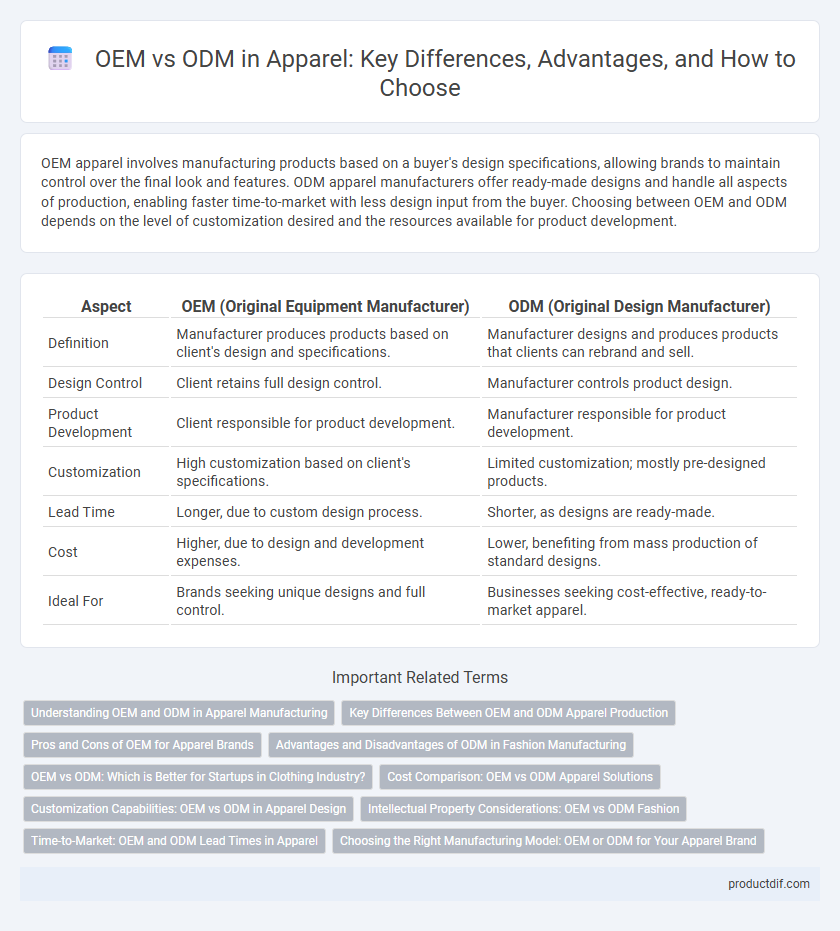OEM apparel involves manufacturing products based on a buyer's design specifications, allowing brands to maintain control over the final look and features. ODM apparel manufacturers offer ready-made designs and handle all aspects of production, enabling faster time-to-market with less design input from the buyer. Choosing between OEM and ODM depends on the level of customization desired and the resources available for product development.
Table of Comparison
| Aspect | OEM (Original Equipment Manufacturer) | ODM (Original Design Manufacturer) |
|---|---|---|
| Definition | Manufacturer produces products based on client's design and specifications. | Manufacturer designs and produces products that clients can rebrand and sell. |
| Design Control | Client retains full design control. | Manufacturer controls product design. |
| Product Development | Client responsible for product development. | Manufacturer responsible for product development. |
| Customization | High customization based on client's specifications. | Limited customization; mostly pre-designed products. |
| Lead Time | Longer, due to custom design process. | Shorter, as designs are ready-made. |
| Cost | Higher, due to design and development expenses. | Lower, benefiting from mass production of standard designs. |
| Ideal For | Brands seeking unique designs and full control. | Businesses seeking cost-effective, ready-to-market apparel. |
Understanding OEM and ODM in Apparel Manufacturing
OEM (Original Equipment Manufacturer) in apparel manufacturing involves producing garments based on a buyer's specific designs and specifications, allowing brands to outsource production while maintaining control over design and branding. ODM (Original Design Manufacturer) offers end-to-end solutions, providing both design and manufacturing services, which enables brands to quickly launch new apparel collections without investing in design resources. Understanding the distinctions between OEM and ODM is crucial for apparel companies to optimize product development, reduce time-to-market, and manage cost efficiencies effectively.
Key Differences Between OEM and ODM Apparel Production
OEM apparel production involves manufacturing garments based on a buyer's specific designs and specifications, where the brand maintains control over product development. ODM apparel production offers pre-designed products developed by the manufacturer, allowing brands to select and customize existing designs, reducing time to market. Key differences include design ownership, customization level, development responsibility, and lead time, making OEM suitable for brands seeking unique products and ODM ideal for faster, cost-effective market entry.
Pros and Cons of OEM for Apparel Brands
OEM (Original Equipment Manufacturer) offers apparel brands cost-effective production with faster time-to-market by utilizing established manufacturing facilities and standardized processes. However, reliance on OEM limits design customization and may result in less control over product quality and intellectual property. Brands prioritizing unique design differentiation and strict quality oversight might find OEM less suitable compared to ODM options.
Advantages and Disadvantages of ODM in Fashion Manufacturing
ODM in fashion manufacturing offers the advantage of fully designed products, saving brands time on development and enabling faster market entry. This approach can limit customization options, reducing brand differentiation compared to OEM manufacturing where brands have more control over design. Dependence on the ODM's design expertise may also lead to challenges in aligning products with specific brand identity or trends.
OEM vs ODM: Which is Better for Startups in Clothing Industry?
OEM (Original Equipment Manufacturer) offers startups in the clothing industry the advantage of cost efficiency by providing pre-designed products that require minimal customization, allowing faster market entry. ODM (Original Design Manufacturer) supports startups by delivering fully designed apparel with branding flexibility, ideal for those seeking unique products without investing in design resources. Choosing between OEM and ODM depends on the startup's priorities: OEM suits those prioritizing speed and budget, while ODM benefits startups aiming for distinct brand identity and innovation.
Cost Comparison: OEM vs ODM Apparel Solutions
OEM apparel solutions typically offer lower upfront costs due to established production processes and bulk manufacturing, benefiting brands with clear design specifications. ODM apparel solutions may incur higher initial investments as they include design development and customization but can reduce long-term expenses by streamlining innovation and product differentiation. Evaluating total cost of ownership reveals OEM suits brands prioritizing cost-efficiency, while ODM favors those seeking unique, market-responsive apparel with potentially higher margins.
Customization Capabilities: OEM vs ODM in Apparel Design
OEM in apparel design offers customization primarily through manufacturing based on client-provided specifications, allowing brands to maintain control over design elements while benefiting from external production expertise. ODM provides more extensive customization capabilities by delivering ready-made designs that can be modified according to brand requirements, streamlining the product development process. Both OEM and ODM models enhance apparel customization, but ODM enables faster innovation with design input integrated early in the production cycle.
Intellectual Property Considerations: OEM vs ODM Fashion
OEM fashion manufacturing requires brands to supply detailed designs, retaining full intellectual property rights, while ODM partners develop original designs but may claim partial rights, necessitating clear agreements. Protecting trade secrets and design patents is critical in OEM arrangements to prevent unauthorized replication. ODM collaborations demand thorough IP contracts to define ownership, usage rights, and confidentiality obligations, ensuring brand identity remains secure.
Time-to-Market: OEM and ODM Lead Times in Apparel
OEM (Original Equipment Manufacturer) apparel production typically offers shorter lead times since designs are provided by the buyer, enabling faster manufacturing and quicker market entry. ODM (Original Design Manufacturer) involves design development alongside production, which extends lead times but provides unique, customizable apparel solutions for brands aiming to differentiate. Choosing between OEM and ODM impacts time-to-market depending on the balance between speed and design innovation in apparel product development.
Choosing the Right Manufacturing Model: OEM or ODM for Your Apparel Brand
Choosing between OEM and ODM manufacturing models depends on your apparel brand's need for customization and control. OEM (Original Equipment Manufacturer) allows brands to design their own products and outsource production, ensuring unique designs but requiring strong design capabilities. ODM (Original Design Manufacturer) offers ready-made designs with minor modifications, providing faster time-to-market and reduced development costs, ideal for brands prioritizing efficiency over extensive product differentiation.
OEM vs ODM Infographic

 productdif.com
productdif.com